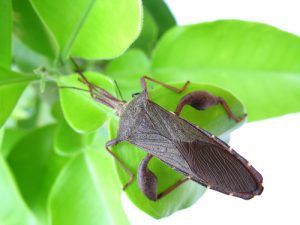Keeping Seed Bugs Out This Fall
By Chris Williams on September 1, 2011.
Q. We had a problem in our home last year with what I’ve been told is the western conifer seed bug. What can I do to keep them from getting inside again this fall?
A. You’re right, the western conifer seed bug is one of our fall invading pests. During the warm months, it’s an outside plant pest feeding on the seeds and cones of conifer trees. But when the weather cools in the fall, it looks for a warm place to spend the winter and often ends up inside homes. Once inside, seed bugs look for a protected place such as inside wall voids or in attics. They show up again in the spring (or on warm days in the winter) when they come out of hiding and try to find their way back outside.
 The western conifer seed bug is a nuisance pest. It doesn’t bite or sting, or reproduce inside, or damage anything in your home. It can give off a defensive odor, though, if it is threatened or handled. For this reason, it is sometimes called a stink bug and is confused with the brown marmorated stink bug, which is a serious fall invader in most of the U.S. Although the brown marmorated stink bug has been reported in our area, it is not yet a problem pest here. The two bugs do look somewhat similar (both are brownish-gray with white markings), but the western conifer seed bug has distinctive flattened leaf-shape extensions on its back legs. The seed bug is larger at 3/4 inch long, while the stink bug is 1/2 inch long. You can see a picture of the western conifer seed bug in our Pest Library under “Occasional Invaders.”
The western conifer seed bug is a nuisance pest. It doesn’t bite or sting, or reproduce inside, or damage anything in your home. It can give off a defensive odor, though, if it is threatened or handled. For this reason, it is sometimes called a stink bug and is confused with the brown marmorated stink bug, which is a serious fall invader in most of the U.S. Although the brown marmorated stink bug has been reported in our area, it is not yet a problem pest here. The two bugs do look somewhat similar (both are brownish-gray with white markings), but the western conifer seed bug has distinctive flattened leaf-shape extensions on its back legs. The seed bug is larger at 3/4 inch long, while the stink bug is 1/2 inch long. You can see a picture of the western conifer seed bug in our Pest Library under “Occasional Invaders.”
You can keep both bugs out of your home in the fall by (1) sealing and screening openings to the inside, and (2) having a professional treat the exterior of your home. These are steps you should take in advance of the seed bug’s fall migration:
· Pay particular attention to windows and doors since these are primary entry points. The seed bugs congregate on the outside walls of houses and around windows and doors. Repair and tighten existing screens; replace missing screens.
· Install sweeps or thresholds at the bottom of doors if you don’t already have them. Don’t forget the garage door; make sure it seals tightly. Caulk around window and door frames.
· Caulk on the outside wherever utility lines or pipes enter the house. Fill the openings around these lines where seed bugs can enter. Caulk around chimneys and underneath wood fascia.
· Screen vents and other large openings to the outside that can’t be caulked or filled.
· One of the primary entry points that people don’t consider is the window air conditioning unit. Remove your window unit as soon as you comfortably can in the fall and tape or seal the opening.
· Seal openings between the inside of your home and the attic (where the bugs often end up) such as around ceiling light fixtures or exhaust fans.
· Outside, plan on an early fall yard cleanup, especially around the perimeter of your home. Seed bugs hide under piles of leaves or mulch, under boards, and debris. Store firewood away from the house. Removing hiding places around your home will reduce the numbers of bugs.
For homes that have a serious problem with the seed bugs, an exterior perimeter treatment in early fall will kill the bugs before they can get into your home. An exterior treatment leaves the pesticide outside, not in your home. Once inside, the seed bugs are difficult to control with pesticides since they disperse into so many different hiding places. Call Colonial to schedule your exterior protective treatment. We can also help with pest-proofing your home, sealing all those openings that bugs use to get in. We do pests so you don’t have to!